Cell - the unit of life 1000+ MCQ with answer for UPSC CSE
Thursday 9th of March 2023

Sharing is caring
1. Study the following statements on cilium or flagellum and answer the question.
Which of the above statements are correct?
A. (i) and (ii)
B. (i), (ii), (iii) and (iv)
C. (i) and (iv)
D. (ii) and (iii)
Answer : B
- Cilium / Flagellum contains an outer ring of nine doublet microtubules surrounding two singlet microtubules.
- Cilia are smaller which work like oars, causing the movement of either the cells or surrounding fluid.
- Flagella are comparatively longer and responsible for cell movement.
- Cilium and flagellum are covered with plasma membrane.
Which of the above statements are correct?
A. (i) and (ii)
B. (i), (ii), (iii) and (iv)
C. (i) and (iv)
D. (ii) and (iii)
Answer : B
2. The following diagram shows some of the missing structures in a plant cell marked as A, B, C, D E. Choose the option with their correct names.
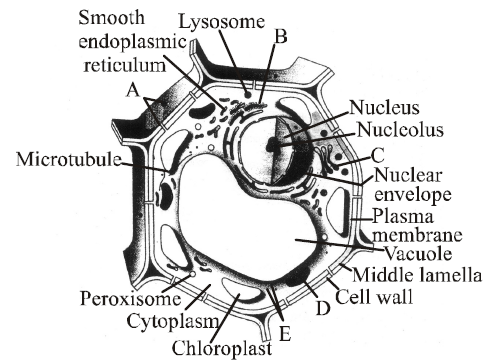
A. A - Plasmodesmata, B - Rough endoplasmic reticulum, C - Golgi apparatus, D - Mitochondrion, E - Ribosomes
B. A - Desmosome, B - Rough endoplasmic reticulum, C - Golgi apparatus, D - Mitochondrion, E - Ribosomes
C. A - Plasmodesmata, B - Smooth endoplasmic reticulum, C - Golgi apparatus, D - Mitochondrion, E - Ribosomes
D. A - Tight junction, B - Rough endoplasmic reticulum, C - Golgi apparatus, D - Mitochondrion, E -Ribosomes
Answer : A

A. A - Plasmodesmata, B - Rough endoplasmic reticulum, C - Golgi apparatus, D - Mitochondrion, E - Ribosomes
B. A - Desmosome, B - Rough endoplasmic reticulum, C - Golgi apparatus, D - Mitochondrion, E - Ribosomes
C. A - Plasmodesmata, B - Smooth endoplasmic reticulum, C - Golgi apparatus, D - Mitochondrion, E - Ribosomes
D. A - Tight junction, B - Rough endoplasmic reticulum, C - Golgi apparatus, D - Mitochondrion, E -Ribosomes
Answer : A
3. Microtubules are absent in
A. mitochondria
B. centriole
C. flagella
D. spindle fibres
Answer : A
A. mitochondria
B. centriole
C. flagella
D. spindle fibres
Answer : A
4. Match column-I and column-II and select the correct answer
A. A III; B IV; C II; D I
B. A II; B IV; C III; D I
C. A I; B II; C III; D IV
D. A IV; B III; C I ; D II
Answer : B
| Column-I | Column-II |
|---|---|
| A. Bacteria without walls | I. Lysosome |
| B. Small circular DNA | II. Mycoplasma cells |
| C. Flattened sacs in | III. Thylakoid a chloroplast |
| D. A vesicle in which | IV. Plasmid hydrolytic enzymes are stored |
A. A III; B IV; C II; D I
B. A II; B IV; C III; D I
C. A I; B II; C III; D IV
D. A IV; B III; C I ; D II
Answer : B
5. Microtubules, motor proteins, and actin filaments are all part of the
A. mechanism of photosynthesis that occurs in chloroplasts.
B. rough ER in prokaryotic cells.
C. cytoskeleton of eukaryotic cells.
D. process that moves small molecules across cell membranes.
Answer : C
A. mechanism of photosynthesis that occurs in chloroplasts.
B. rough ER in prokaryotic cells.
C. cytoskeleton of eukaryotic cells.
D. process that moves small molecules across cell membranes.
Answer : C
6. The lipid component of the membrane mainly consists of __________.
A. polysaccharides
B. phosphoglyceride
C. monosaccharaides
D. both (a) and (c)
Answer : B
A. polysaccharides
B. phosphoglyceride
C. monosaccharaides
D. both (a) and (c)
Answer : B
7. Match column-I (scientists) with column-II (discovery) and select the correct option.
A. A I, B III, C IV, D II
B. A I, B III, C II, D IV
C. A III, B I, C IV, D II
D. A I, B IV, C II, D III
Answer : A
| Column-I | Column-II |
|---|---|
| A. Leeuwenhoek | I. First saw and described a living cell |
| B. Robert Brown | II. Presence of cell wall is unique to plant cells |
| C. Schleiden | III. Discovered the nucleus |
| D. Schwann | IV. All plants are composed of different kind of cells |
A. A I, B III, C IV, D II
B. A I, B III, C II, D IV
C. A III, B I, C IV, D II
D. A I, B IV, C II, D III
Answer : A
8. Golgi apparatus is absent in
A. higher plants
B. yeast
C. bacteria and blue-green algae
D. None of the above
Answer : C
A. higher plants
B. yeast
C. bacteria and blue-green algae
D. None of the above
Answer : C
9. Which one of the following structures between two adjacent cells is an effective transport pathway?
A. Plasmodesmata
B. Plastoquinones
C. Endoplasmic reticulum
D. Plasmalemma
Answer : A
A. Plasmodesmata
B. Plastoquinones
C. Endoplasmic reticulum
D. Plasmalemma
Answer : A
10. 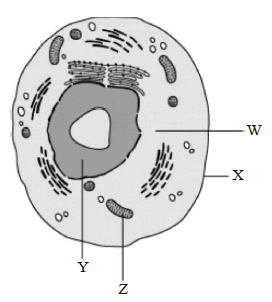
Which cellular structure helps in transferring genetic information from one generation to another?
A. W
B. X
C. Y
D. Z
Answer : C

Which cellular structure helps in transferring genetic information from one generation to another?
A. W
B. X
C. Y
D. Z
Answer : C
11. In the given figure of animal cell, one orginelle is marked as A. Select the correct identification and function of the organelle A from the given option.
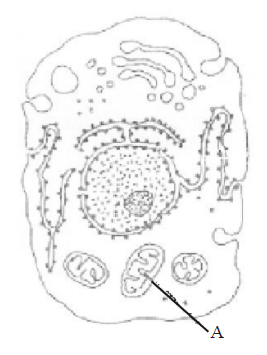
A. Endoplasmic reticulum Synthesis of lipids.
B. Mitochondria Produce cellular energy in the form of ATP.
C. Golgi body Provides packaging material.
D. Lysosomes Secrete hydrolytic enzymes.
Answer : B

A. Endoplasmic reticulum Synthesis of lipids.
B. Mitochondria Produce cellular energy in the form of ATP.
C. Golgi body Provides packaging material.
D. Lysosomes Secrete hydrolytic enzymes.
Answer : B
12. Select the incorrect statement about prokaryotic ribosomes.
A. 50S and 30S subunits unite to form 70S ribosomes.
B. Polysome/polyribosome consists of many ribosomes only.
C. Ribosome is the site of protein synthesis.
D. Polysome indicate the synthesis of identical poolypeptide in multiple copies.
Answer : B
A. 50S and 30S subunits unite to form 70S ribosomes.
B. Polysome/polyribosome consists of many ribosomes only.
C. Ribosome is the site of protein synthesis.
D. Polysome indicate the synthesis of identical poolypeptide in multiple copies.
Answer : B
13. Membranous extensions in blue green algae are known as
A. phytochrome
B. chromatophore
C. mesosome
D. pneumatophore
Answer : B
A. phytochrome
B. chromatophore
C. mesosome
D. pneumatophore
Answer : B
14. Plastids storing fat are called
A. Elaioplasts
B. Sphaerosomes
C. Aleuroplasts
D. Pyrenoids
Answer : A
A. Elaioplasts
B. Sphaerosomes
C. Aleuroplasts
D. Pyrenoids
Answer : A
15. Which of the following is absent in prokaryotes?
A. DNA
B. RNA
C. Plasma membrane
D. Mitochondria
Answer : D
A. DNA
B. RNA
C. Plasma membrane
D. Mitochondria
Answer : D
16. The membrane of the erythrocytes has approximately ___% of proteins and ___% lipids.
A. 42, 50
B. 52, 40
C. 50, 50
D. 60, 40
Answer : B
A. 42, 50
B. 52, 40
C. 50, 50
D. 60, 40
Answer : B
17. Both the membranes of mitochondrion are
A. strcturally different but functionally similar.
B. structurally as well as functionally different.
C. structurally similar but functionally different.
D. structurally different but functionally similar.
Answer : B
A. strcturally different but functionally similar.
B. structurally as well as functionally different.
C. structurally similar but functionally different.
D. structurally different but functionally similar.
Answer : B
18. Match column-I with column-II and choose the correct option.
A. A IV; B III; C I; D II
B. A II; B III; C IV; D I
C. A IV; B II; C III; D I
D. A I; B III; C II; D IV
Answer : A
| Column-I | Column-II |
|---|---|
| A. Tonoplast | I. Contain digestive enzyme |
| B. Contractile vacuole | II. Store metabolic gases |
| C. Food vacuole | III. Excretion |
| D. Air vacuole | IV. Transport of ions in plants |
A. A IV; B III; C I; D II
B. A II; B III; C IV; D I
C. A IV; B II; C III; D I
D. A I; B III; C II; D IV
Answer : A
19. Given below are some characters of a cell organelle identify the correct organelle which shows all the characters described above.
A. Golgi apparatus
B. Lysosomes
C. Endoplasmic reticulum
D. Vacuoles
Answer : D
- It is a membrane bound space found in the cytoplasm.
- It is bound by a single membrane called tonoplast.
- It contains water, sap, excretory products and other materials not useful to the cell.
- It has higher concentration of sap than the cytoplasm.
A. Golgi apparatus
B. Lysosomes
C. Endoplasmic reticulum
D. Vacuoles
Answer : D
20. The following diagram represents a structure chromosome.
Identify the structures marked as A, B and C.
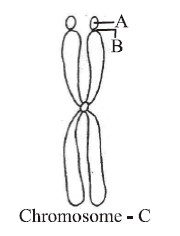
A. A - Satellite, B - Primary constriction, C - Acrocentric
B. A - Satellite, B - Secondary constriction, C - Metacentric
C. A - Satellite, B - Centromere, C - Telocentric
D. A - Satellite, B - Centromere, C - Submetacentric
Answer : B
Identify the structures marked as A, B and C.

A. A - Satellite, B - Primary constriction, C - Acrocentric
B. A - Satellite, B - Secondary constriction, C - Metacentric
C. A - Satellite, B - Centromere, C - Telocentric
D. A - Satellite, B - Centromere, C - Submetacentric
Answer : B
21. Select the correct match of the types of neuron present in column I with its location given in column II.
A. A - (i), B - (ii), C - (iii), D - (iv)
B. A - (iii), B - (i), C - (ii), D - (iv)
C. A - (iii), B - (i), C - (iv), D - (ii)
D. A - (i), B - (iv), C - (iii), D - (ii)
Answer : B
| Column I | Column II |
|---|---|
| A. Centrioles | (i) Non-membrane bound organelle which helps in cell division |
| B. Fimbriae | (ii) Special structure of bacteria which help them to attach with rocks in stream and also to host tissue |
| C. Endomembrane | (iii) Includes those organelles system whose functions are coordinated |
| D. Mitochondria | (iv) Divide by fission and site of aerobic respiration |
A. A - (i), B - (ii), C - (iii), D - (iv)
B. A - (iii), B - (i), C - (ii), D - (iv)
C. A - (iii), B - (i), C - (iv), D - (ii)
D. A - (i), B - (iv), C - (iii), D - (ii)
Answer : B
22. pH of vacuolar cell sap is
A. neutral and isotonic.
B. alkaline and isotonic.
C. acidic and hypertonic.
D. equal to cytoplasm and isotonic.
Answer : C
A. neutral and isotonic.
B. alkaline and isotonic.
C. acidic and hypertonic.
D. equal to cytoplasm and isotonic.
Answer : C
23. _______________ is the important site of formation of glycoproteins and golycolipids.
A. SER
B. Lysosome
C. Golgi apparatus
D. Mitochondria
Answer : C
A. SER
B. Lysosome
C. Golgi apparatus
D. Mitochondria
Answer : C
24. The diagram given below represent a filuid mosaic model of plasma membrance. Match the components marked as A, B, C, D and E in the diagram below from the list (i) to (vii).
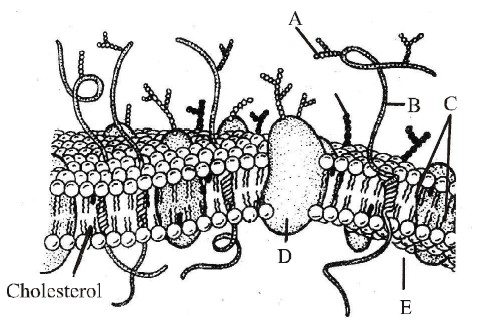
A. A - (i), B - (ii), C - (iii), D - (iv), E - (v)
B. A - (ii), B - (i), C - (iii), D - (iv), E - (v)
C. A - (i), B - (ii), C - (iii), D - (iv), E - (vi)
D. A - (i), B - (ii), C - (iii), D - (vii), E - (v)
Answer : A

- Sugar
- Protein
- Lipid bilayer
- Integral protein
- Cytoplasm
- Cell wall
- External protein
A. A - (i), B - (ii), C - (iii), D - (iv), E - (v)
B. A - (ii), B - (i), C - (iii), D - (iv), E - (v)
C. A - (i), B - (ii), C - (iii), D - (iv), E - (vi)
D. A - (i), B - (ii), C - (iii), D - (vii), E - (v)
Answer : A
25. Which of the following terms is not correctly matched with its feature?
A. Osmosis Movement of water by diffusion.
B. Nucleoplasm Site of active synthesis of ribosomal RNA.
C. Mesosome Infolding of cell membrane and characteristics of eukaryotes.
D. Pili Elongated tubular surface structures (made of special protein) of bacteria.
Answer : C
A. Osmosis Movement of water by diffusion.
B. Nucleoplasm Site of active synthesis of ribosomal RNA.
C. Mesosome Infolding of cell membrane and characteristics of eukaryotes.
D. Pili Elongated tubular surface structures (made of special protein) of bacteria.
Answer : C
26. Which one of the following cellular parts is correctly matched with their characters ?
A. Centrioles Sites for active RNA synthesis.
B. Lysosomes Optimally active at a pH of about 8.5.
C. Thylakoids Flattened membranous sacs forming the grana of chloroplasts.
D. Ribosomes Those on chloroplasts are larger (80S) while those in the cytoplasm are smaller (70S).
Answer : C
A. Centrioles Sites for active RNA synthesis.
B. Lysosomes Optimally active at a pH of about 8.5.
C. Thylakoids Flattened membranous sacs forming the grana of chloroplasts.
D. Ribosomes Those on chloroplasts are larger (80S) while those in the cytoplasm are smaller (70S).
Answer : C
27. Which of the following statements is/are correct ?
A. (i), (ii), (iii) and (iv)
B. Only (i) and (ii)
C. Only (iv)
D. None of the above
Answer : A
- The shape of the cells may vary with the function they perform.
- Human RBC is about 7.0 ??m in diameter.
- Cytoplasm is the main area of cellular activities.
- Various chemical reactions occur in cytoplasm to keep the cell in the living state.
A. (i), (ii), (iii) and (iv)
B. Only (i) and (ii)
C. Only (iv)
D. None of the above
Answer : A
28. Axoneme with 9 + 2 microtubular arrangement occurs in
A. cilia
B. flagella
C. both (a) and (b)
D. centriole
Answer : C
A. cilia
B. flagella
C. both (a) and (b)
D. centriole
Answer : C
29. Basal bodies are associated with the formation of
A. phragmoplast
B. cilia and flagella
C. cell plate
D. kinetochore
Answer : B
A. phragmoplast
B. cilia and flagella
C. cell plate
D. kinetochore
Answer : B
30. Protein synthesis in an animal cell occurs
A. on ribosomes present in cytoplasm as well as in mitochondria.
B. on ribosomes present in the nucleolus as well as in cytoplasm.
C. only on ribosomes attached to the nuclears envelope and endoplasmic reticulum.
D. only on the ribosomes present in cytosol.
Answer : A
A. on ribosomes present in cytoplasm as well as in mitochondria.
B. on ribosomes present in the nucleolus as well as in cytoplasm.
C. only on ribosomes attached to the nuclears envelope and endoplasmic reticulum.
D. only on the ribosomes present in cytosol.
Answer : A
31. Satellite means
A. terminal part of the chromosome beyond secondary constriction.
B. terminal part of the chromosome beyond primary constriction.
C. terminal part of chromosome beyond tertiary constriction.
D. none of the above
Anser : A
A. terminal part of the chromosome beyond secondary constriction.
B. terminal part of the chromosome beyond primary constriction.
C. terminal part of chromosome beyond tertiary constriction.
D. none of the above
Anser : A
32. In which of the following the cells are held together by a Ca-pectate layer?
A. Primary cell wall
B. Secondary cell wall
C. Middle lamella
D. Tertiary cell wall
Answer : C
A. Primary cell wall
B. Secondary cell wall
C. Middle lamella
D. Tertiary cell wall
Answer : C
33. The given figures show two types of cell. Which structures are common to both the cells?

A. Nucleus and cell wall
B. Nucleus and cytoplasm
C. Ribosomes and flagella
D. Ribosomes and cell wall
Answer : D

A. Nucleus and cell wall
B. Nucleus and cytoplasm
C. Ribosomes and flagella
D. Ribosomes and cell wall
Answer : D
34. Read the statements given below with regard to the functions performed by Golgi apparatus ?
Which of the following is the correct answer ?
A. (i) is wrong but (ii) and (iii) are correct
B. (ii) is wrong but (i) and (iii) are correct
C. (ii) and (iii) are wrong but (i) is correct
D. All are correct.
Answer : D
- Transport and chemically modify the materials contained within it.
- Performs the function of packaging materials.
- Important site of formation of glycoproteins and glycolipids.
Which of the following is the correct answer ?
A. (i) is wrong but (ii) and (iii) are correct
B. (ii) is wrong but (i) and (iii) are correct
C. (ii) and (iii) are wrong but (i) is correct
D. All are correct.
Answer : D
35. Which of the following statements is/are correct ?
A. (ii), (iii) & (iv)
B. (i) only
C. (ii) only
D. (iii) only
Answer : A
- The endomembrane system includes plasma membrane, ER, Golgi complex, lysosomes and vacuoles.
- ER helps in the transport of substances, synthesis of proteins, lipoproteins and glycogen.
- Ribosomes are involved in protein synthesis.
- Mitochondria help in oxidative phosphorylation and generation of ATP.
A. (ii), (iii) & (iv)
B. (i) only
C. (ii) only
D. (iii) only
Answer : A
36. According to widely accepted fluid mosaic model cell membranes are semi-fluid, where lipids and integral proteins can diffuse randomly. In recent years, this model has been modified in several respects. In this regard, which of the following statements is incorrect?
A. Proteins in cell membranes can travel within the lipid bilayer.
B. Proteins can also undergo flip-flop movements in the lipid bilayer.
C. Proteins can remain confined within certain domains of the membrane.
D. Many proteins remain completely embedded within the lipid bilayer.
Answer : B
A. Proteins in cell membranes can travel within the lipid bilayer.
B. Proteins can also undergo flip-flop movements in the lipid bilayer.
C. Proteins can remain confined within certain domains of the membrane.
D. Many proteins remain completely embedded within the lipid bilayer.
Answer : B
37. A component of cytoskeleton is
A. microtubule
B. bone
C. chitin
D. cartilage.
Answer : A
A. microtubule
B. bone
C. chitin
D. cartilage.
Answer : A
38. You are asked to examine a cell using a powerful light microscope. The image you see has a clearly defined nucleus and mitochondria. It also has a large central vacuole and chloroplasts. From what group of organisms did this cell most likely come?
A. Bacteria
B. Protists
C. Fungi
D. Plants
Answer : D
A. Bacteria
B. Protists
C. Fungi
D. Plants
Answer : D
39. Which of the following statements are correct ?
A. (iii) and (iv)
B. (i) and (ii)
C. (ii) and (iii)
D. (i) and (iv)
Answer : A
- In prokaryotic cells, a special membranous structure formed by the extension of the plasma membrane into the cell is known as polysome.
- The smooth endoplasmic reticulum is the major site for synthesis of glycoproteins.
- RuBisCO is the most abundant protein in the whole biosphere.
- Mitochondria, chloroplasts and peroxisomes are not considered as part of endomembrane system. Of the above statements
A. (iii) and (iv)
B. (i) and (ii)
C. (ii) and (iii)
D. (i) and (iv)
Answer : A
40. Which of the following is not the function of cell wall?
A. Only (i)
B. Only (iv)
C. Only (ii), (iii) and (iv)
D. None of the above
Answer : D
- Provides shape to the cell.
- Protects the cell from mechanical damage and infection.
- Helps in cell to cell interaction.
- Provides barrier to undesirable macromolecules.
A. Only (i)
B. Only (iv)
C. Only (ii), (iii) and (iv)
D. None of the above
Answer : D
41. Grana are
A. protein storing plastids.
B. coloured plastids.
C. stacks of thylakoids.
D. individual thylakoids present in stroma.
Answer : C
A. protein storing plastids.
B. coloured plastids.
C. stacks of thylakoids.
D. individual thylakoids present in stroma.
Answer : C
42. 9.A student was given cell samples (A and B) to identify parts which are highlighted. He observed the samples under the microscope and list down the function of the part of cell sample. The information collected by the student is listed in the table below, on the basis of which the student infers that the samples contain the organelles.
Explain why the samples were belonged to eukaryotic cell and not prokaryotic cell? Because,
A. eukaryotic cell have membrane bound organelles.
B. eukaryotic cell have non - membrane bound organelles.
C. eukaryotic cell are smaller and multiply more rapidly than prokaryotic cells.
D. eukaryotic cell are larger and multiply more rapidly than prokaryotic cells.
Answer : B
| Sample A | Sample B |
|---|---|
| Make energy available for cellular metabolism | Generates ATP and synthes izes s ugar |
| Absent in cell that carry oxygen throughout the body | Present in plant cell |
| Called the energy currency of cell | Source o f all the food energy |
Explain why the samples were belonged to eukaryotic cell and not prokaryotic cell? Because,
A. eukaryotic cell have membrane bound organelles.
B. eukaryotic cell have non - membrane bound organelles.
C. eukaryotic cell are smaller and multiply more rapidly than prokaryotic cells.
D. eukaryotic cell are larger and multiply more rapidly than prokaryotic cells.
Answer : B
43. 8.A student was given cell samples (A and B) to identify parts which are highlighted. He observed the samples under the microscope and list down the function of the part of cell sample. The information collected by the student is listed in the table below, on the basis of which the student infers that the samples contain the organelles.
Identify the part highlighted in the sample A and B and explain why they were called as semi-autonomous organelles?
A. Sample A - Mitochondria, Sample B - Chloroplast; because both the organelles are double membrane bound structure.
B. Sample A- Mitochondria, Sample B - Chloroplast; because they both are capable of synthesis of their own proteins only.
C. Sample A - Mitochondria, Sample B - Chloroplast; because they are capable of synthesis of their own proteins and contain their own DNA.
D. Sample A- Mitochondria, Sample B - Chloroplast; because they conain their own DNA to transfer the genetic information from one generation to another.
Answer : C
| Sample A | Sample B |
|---|---|
| Make energy available for cellular metabolism | Generates ATP and synthes izes s ugar |
| Absent in cell that carry oxygen throughout the body | Present in plant cell |
| Called the energy currency of cell | Source o f all the food energy |
Identify the part highlighted in the sample A and B and explain why they were called as semi-autonomous organelles?
A. Sample A - Mitochondria, Sample B - Chloroplast; because both the organelles are double membrane bound structure.
B. Sample A- Mitochondria, Sample B - Chloroplast; because they both are capable of synthesis of their own proteins only.
C. Sample A - Mitochondria, Sample B - Chloroplast; because they are capable of synthesis of their own proteins and contain their own DNA.
D. Sample A- Mitochondria, Sample B - Chloroplast; because they conain their own DNA to transfer the genetic information from one generation to another.
Answer : C
44. Which of the following organelles is directly connected to the outer membrane of the nucleus in a eukaryotic cell?
A. Mitochondrion
B. Lysosome
C. Golgi apparatus
D. Endoplasmic reticulum
Answer : D
A. Mitochondrion
B. Lysosome
C. Golgi apparatus
D. Endoplasmic reticulum
Answer : D
45. Match column I (cell type) with column II (size) and choose the correct option.
A. A I, B II, C III, D IV
B. A IV, B III, C II, D I
C. A I, B III, C II, D IV
D. A IV, B II, C III, D I
Answer : B
| Column-I | Column-II |
|---|---|
| (Cell type) | (Size) |
| A. Viruses | I. 1-2 ??m |
| B. PPLO | II. 10-20 ??m |
| C. Eukaryotic cell | III. About 0.1 ??m |
| D. Bacterium | IV. 0.02 - 0.2 ??m |
A. A I, B II, C III, D IV
B. A IV, B III, C II, D I
C. A I, B III, C II, D IV
D. A IV, B II, C III, D I
Answer : B
46. The main organelle involved in modification and routing of newly synthesized proteins to their destinations is
A. chloroplast
B. mitochondria
C. lysosome
D. endoplasmic reticulum
Answer : D
A. chloroplast
B. mitochondria
C. lysosome
D. endoplasmic reticulum
Answer : D
47. Which one of the following organelle given below is correctly matched with its function ?
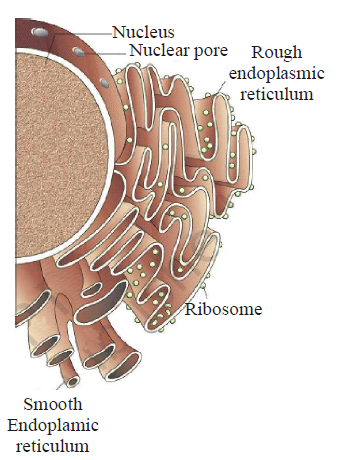
A. Golgi apparatus Protein synthesis
B. Golgi apparatus Formation of glycolipids
C. Rough endoplasmic reticulum Protein synthesis
D. Rough endoplasmic reticulum Formation of glycoproteins
Answer : C

A. Golgi apparatus Protein synthesis
B. Golgi apparatus Formation of glycolipids
C. Rough endoplasmic reticulum Protein synthesis
D. Rough endoplasmic reticulum Formation of glycoproteins
Answer : C
48. Active transport across biomembrane involves
A. production of ATP
B. requirement of energy
C. production of toxin
D. release of energy
Answer : B
A. production of ATP
B. requirement of energy
C. production of toxin
D. release of energy
Answer : B
49. Most of water, in mature plant cells occurs in
A. nucleus
B. cell wall
C. vacuoles
D. cytoplasm
Answer : C
A. nucleus
B. cell wall
C. vacuoles
D. cytoplasm
Answer : C
50. Which one of the following combination is mismatched?
A. Glycocalyx May be capsule or slime layer
B. Pili Reproduction
C. Cell wall Protective, determines shape, prevents from bursting
D. Flagella, pili and fimbriae Surface structures of bacterial cell
Answer : B
A. Glycocalyx May be capsule or slime layer
B. Pili Reproduction
C. Cell wall Protective, determines shape, prevents from bursting
D. Flagella, pili and fimbriae Surface structures of bacterial cell
Answer : B
Sharing is caring
Related Post
RBI Grade B officer - Biological Classification 1000+ MCQ [Solved] PDF Download
CorelDraw 1000+ MCQ with answer for GATE
Microsoft Excel MCQ Solved Paper for SBI PO
IBPS PO - Morphology of flowering plants 1000+ MCQ [Solved] PDF Download
CEED - Idioms & Phrases 1000+ MCQ [Solved] PDF Download
Chemical Engineering Plant Economics MCQ Solved Paper for SSC MTS